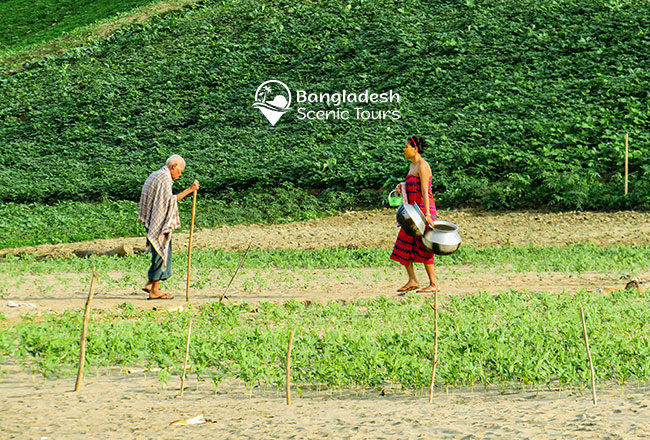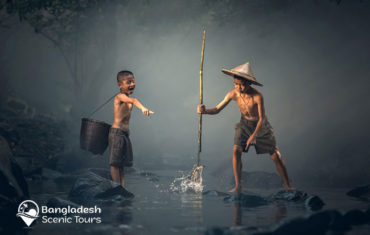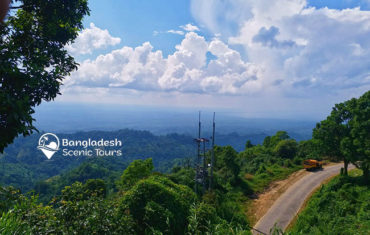Bangladesh is the home of a notable number of tribal people. The mainstream tribal people in Bangladesh are available in Chittagong Hill Tracts (CHT) areas.
Their life and living are amazing and most of them are the followers of Buddhism. Besides, you can also find some Christians, Hindus, and followers of other religions as well. Though they follow religions, they are still primitive to some extent which is demonstrated in their everyday life.
Interestingly, the families in the areas have domination of matriarchy. Mother is the all in all in a family which is not seen in the other local people. Women are hard workers and produce all the essential elements of their society. Males are not so much hard-working and their participation is limited to some extent.
Being self-reliant, the tribal people produce their food, weave their clothes. But they lead a very simple life. Besides, the dialects for each of the tribes are different. Their dress code is also dissimilar.
Some of the tribes are hunters and they hunt using bow and arrows. While visiting the areas, you can find some wonderful handicrafts from the tribal women.
But in general, the tribal people love to stay in peace and friendly to visitors and tourists. Let’s know more about tribal people in Bangladesh.
The Chakmas
In Bangladesh, Chakmas are larger than any other tribe. A 1991 census counted the members of the tribe over 200,000. Besides, it is estimated that some of the members of the tribe live in the neighboring Assam, Arunachal Pradesh, Tripura and Mizoram of India. They are also available in Cox’s Bazar and neighboring Myanmar.
They have a distinctive language and it belongs to the Indo-European family. The language also has a close link with Bengali, Assamese, and Pali. Interestingly, the Chakma people use their customized scripts. But the script is similar to Burmese and Mon Khmer.
The majority of the senior Chakma people use the script for signing but the trend is changing now. The youths are now entering into the mainstream language and scripts of the country. They now learn English and Bengali languages too.
The Chakmas are gentle in nature and usually do not socialize without their respective people. But if you can move inside with a conversation, you will find them very cordial.
The society is headed by a chief and they follow the chief’s advice when they are in trouble. The chief descends from a family that leads a movement against the colonial rulers.
Most of the Chakmas follow Buddhism.
The Marmas
In Bangladesh, the Marmas are second in the ladder in terms of the number of population. Following the 1991 census, a total of 142,334 Marmas live in the CHT areas.
They are mostly Theravadan Buddhists and live in the southern part of the Chittagong Hill Tracts. They are loyal to Bohmong Chief. Besides, they have their respective script and the language they speak is identical to Rakhine. However, the language is sweet and there is a poetic tone available as well.
Education among the Marmas is more prevalent and they learn using the Bengali language. But it was a disadvantage for them. So, for the progress of their education, this is necessary to take steps to start teaching in their local language. And the language needs official recognition too for its lucidity.
The love of music and drama has made them special among the other tribal people in the country. They have different types of performances like folk dance, operatic performance, among others. They also love fairs and funs. Celebration of religious events and festivals is the feature of this tribe.
Both men and women of the tribe love smoking and they also consume rice beer regardless of their gender.
Most of the Marma people are farmers. But you will also find doctors, traders, service holders and other professionals among them. In fact, the Marmas are the best traders in all terms among other tribal people in Bangladesh.
The Tripuras
The number of members of this tribe is relatively lower than the other tribes. Following the 1991 census, there are only 61, 129 people of the tribe live in Bangladesh and the majority of them live in Khagrachharhi district.
But the mainstream Tripura people live in Tripura state in India while a lower number of them will be found in the CHT, Noakhali and Cumilla districts.
Among the 36 sub-groups, the most famous are Naitong, Noatia, Fatung, among others. The language that they use belongs to Tibeto-Burman family. Religiously, they have their own god but some of them follow Hindu gods as well.
Earlier, the Tripura people were farmers but now they have adopted different modern professions. Some of them are getting university education too. But the study in the Bengali language becomes a barrier for them as they are not so familiar with the language.
To increase their literacy rate, there should be provision of education in their own language.
The Tanchangyas
The breakdown of the name refers to farmers. It is believed that the tribal people of this particular tribe used to grow crops on the hill. Following the 1991 census, the number of Tanchangyas is over 19, 000. They live in the borderline of Chattogram and Rangamati district. Some of them are available in Cox’s Bazar as well.
The majority of them are Buddhist and now have been adopting mainstream societies. No longer they are farmers, they have been entering into different professions including government jobs. Besides, they are also getting university educations as well.
In terms of nature, they are highly romantic. Marriage is a precious custom to them and often the bride is elder than the groom. But the trend has been changed.
Khumi Tribe
The history of the name of this tribe is interesting. In the Khumi language, there is a breakdown in the name into two parts- Khu and mi. And it points out that the best human race. They consider them as the best humans. But the language is changed in the Arakanese language where the meaning comes out as Dog Race.
They believe that dog was the first creation and it saved the humans. So, they are indebted to the dogs and thus took this title. Moreover, they also pay homage to dogs for saving mankind earlier.
Religiously the Khamis are Buddhist while some of them are animists as well. They have several gods and they pay tribute to some other gods for specific purposes.
They are also separated into two clans – ‘wife giver’ and ‘wife receiver’. Regarding the property division, the eldest son of the family gets all the properties.
Their language comes from the southern branch of Kukis. But the number of people living in the country is not substantial. The number was only 2,000 in 1869.
They arrived in the Chattogram area from Arakan during the 17th century. Their houses are on the top of the trees and they love to live on the hill ridges. Bamboo is the key element to make their homes.
The tribe was engaged in warfare and still, they are loyal to their chief. But they also pay the annual tribute to Marma Bohmang chief. Killing a goat with a sharp weapon, they take an oath of loyalty. It is a symbol that the loyalty violator will have the same fate.
The Mros
The Mros have been living in the country for a long time. The population is not substantial here and it was only 1,500 in 1869.
Since they had no tribal chief, they used to associate with the Marma Bohmang chief who has his domination in Bandarban. And they pay collective tribute to the Bohmang chief after collecting them from the villagers.
Religiously, they believe that ‘Turai’ is their creator. They also follow two other deities as their gods. One of them is ‘Oreng’ while the other one is ‘Sungtiang’. But they lack any holy book.
They explain this fact with the religious belief that Turia sent a book to them through a bull. But the bull ate the book and so, they are deprived of the book.
The Lushais
Around 150 years ago, the Lushais migrated here and been living peacefully in the CHT areas. Before their arrival here, they used to live in the mountain tops and were a bit ferocious in nature. Even, people had to undergo several phases of scrutiny before entering their villages.
In religious point, they are animist with Pathian as their god in chief.
This is a patriarchal society and there are several sections in the society. Interestingly, the sole proprietorship goes to the youngest son of the family.
They pay proper respect to the dead members of the family. They do not bury or burn the dead. Rather, they keep the body into a bamboo cage after cladding it in lovely clothes. They also lit a fire for three months beside the body. Later, they remove the bones from the dead body.
Lushai is their language and using Latin script, they write it. In the present day, a large number of them are Christians as the missionaries had their influence on the tribe during the British colonial period.
The Khiangs
According to their belief, the Khiangs came in this land around 200 years ago as their chief sought relief from war. He arrived here with his pregnant wife and left again leaving his wife with some of his soldiers. Now they are a small group of people as they were in 1869.
Despite living in this country, they are influenced by the Burmese chief. Besides, they have a social organization which has similarity with the Khumis and Mros.
They do not have any sub-cast and most of them are Buddhist. They pay tribute to ‘Nada Ga’- a deity for a household. They also follow ‘Bogley’ – the deity for water.
They have a specific language and it belongs to Kuki-Chin group. The language is lucid and has a special appeal.
The Bawms & Pankhus
It is believed that the tribes were originated from two Lushai brothers. They were only 3,000 in number in 1869. The people of the tribe pay tribute to the Bohmang chief. The headmen of the tribes, elected by them, pay the tribute on behalf of the tribes.
The tribal people of both tribes have a belief that they have descendent from ‘Shan’ nation that resides in Burma (presently Myanmar).
Earlier, they built their houses on the mountain tops and they also were ferocious in nature. But after the British annexation. Before the incident, they were skilled in warfare and also used to live amid tight security.
Despite being animists, they have two primary gods – Pathian and Khozing. But some of them are Christians as well since the missionaries had their footsteps in the areas.
The oral language is similar to Lushai and originates from the group named ‘Kuki-Chin.’
Their hairstyles identify them. The population of Bawms ties the hair in the middle of the head while the Pankhus tie in the back of the head.
Chak Tribe
It is said that the Chaks are a Chakma sub-group. But the views go different too. It is also believed that they have descended from the Saks group who are in the Arakan. However, there is another view that they have descended from the Chakmas living the Chattogram Hill Tracts.
They have an oral language that is similar to Kadu. Kadu is spoken in Myanmar (formerly known as Burma). The language is also used in Manipur of India.
Religiously, the Chaks are Buddhists and they are separated into two sections. They are – Ando and Ngarek.
Thanks for patiently reading the article to the end. If you want to meet the tribal people in Bangladesh you should visit Chittagong Hill Tracts (CHT) areas. We can help in this matter. We are one of the best tour operator in Bangladesh.





